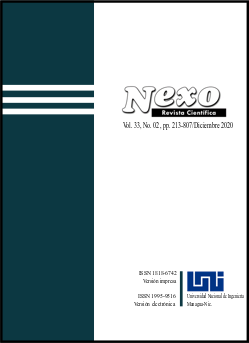Examination of alteration and metasomatic zones based on the tectonic setting of the Kamoo region (northeast of Isfahan, Iran)
DOI:
https://doi.org/10.5377/nexo.v33i02.10764Keywords:
Alteration, Kamoo, Rare Elements, Skarn FormationAbstract
Kamoo region (northeast of Isfahan) has an anticline structure with a northwest-southeast trend. The exposed part of this anticline consists of siltstone-sandstone and Jurassic shale, which is located below the Cretaceous formation as an unconformity. Penetration by magmatic masses (dikes) and mineralization events are mainly related to fault systems and fractures in the region and follow the trend of the anticline. In addition, the intensity and variety of alterations are affected by tectonic factors, with alteration and metasomatic haloes having developed next to crushed areas. The alteration process is the main controller of mineral mass grade in the study area; therefore, iron grade in the Kamoo ore has increased by the effects of alteration. The alteration effects include propylitic haloes, iron hydroxides (limonite), and clay mineralization (argillic). The host rock consists of Jurassic shales with siltstone, sandstone, and Cretaceous limestone. Calcareous formations adjacent to granodiorite masses are the main hosts of iron skarns. The results of this study showed that the mineral samples from Kamoo were relatively rich in Light Rare Earth Elements (LREEs); the average La/Yb ratio is about 18.61 and Eu anomaly is between 0.52 and 1.94. Based on the findings of this study, the origin for Kamoo skarn was consistent with the model presented by Meinert, and the region’s mineralization and alteration characteristics correspond to the conditions prevailing in oceanic subduction and back-arc basin environments.
Downloads
Downloads
Published
How to Cite
Issue
Section
License
Copyright (c) 2021 Array

This work is licensed under a Creative Commons Attribution 4.0 International License.
The authors who publish in Nexo Scientific Journal agree to the following terms:
- Authors retain the copyright and grant the journal the right of the first publication under the license Creative Commons Attribution License https://creativecommons.org/licenses/by/3.0/, which allows others to share the work with a recognition of the authorship of the work and the initial publication in Nexo Scientific Journal.
- Authors may separately establish additional agreements for the non-exclusive distribution of the version of the work published in the journal (for example, in an institutional repository or a book), with the recognition of the initial publication in Nexo Scientific Journal.
- Authors are allowed and encouraged to disseminate their works electronically (for example, in institutional repositories or in their own website) before and during the submission process, as it can lead to productive exchanges, as well as earlier and greater citation of published works.











